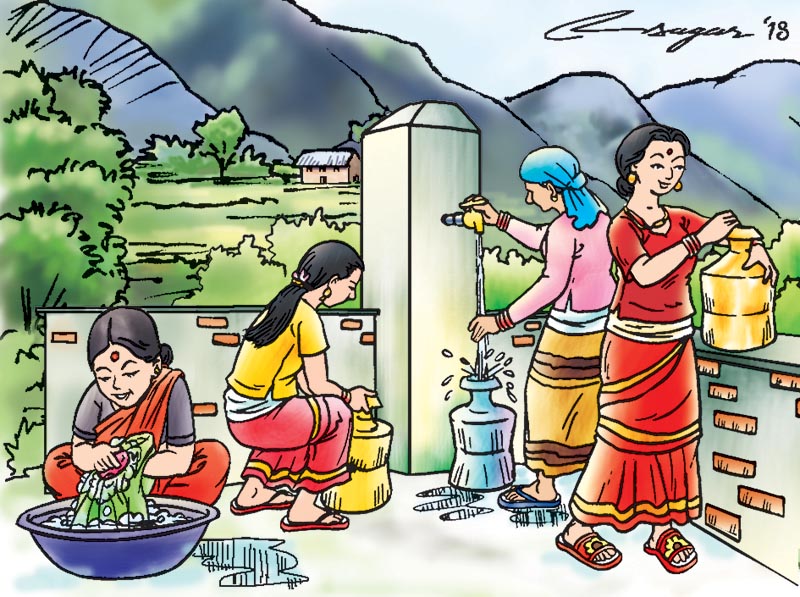Ensuring water security: MUWS best bet in hills
Multiple Use Water Systems not only addresses water scarcity problems of communities but also helps empower women, as the precious time they loss to fetching water from faraway sources can be used in productive activities
Water availability for household and agricultural purposes has been a problem for hilly and mountain regions in Nepal. Majority of conventional water systems are single use systems designed to meet either agricultural or domestic needs.
With some modifications to conventional piped water systems in hilly areas, a new system, called Multiple Use Water Systems (MUWS), was introduced in Nepal in 2003 with the aim of addressing water needs for domestic (drinking, washing and bathing) and productive (irrigation and livestock feeding) purposes. The MUWS refers to water services planning and design of new systems or rehabilitations that start with multiple water uses and reuses of people and their needs at their preferred sites within communities.
It is a participatory and integrated approach with the focus on poverty reduction. The gravity-fed MUWS configurations are considered the simplest and most-effective system. In this approach, water from a higher elevated spring source is collected in storage tanks and supplied to downstream communities. Where gravity-fed MUWS is not viable, water pumps – powered by electricity, diesel or kerosene or renewable energy – are common. The MUWS consists of a single or double chambered intake to capture water at the source which is then transferred to the reservoir tanks near settlements through pipelines. The reservoir tank, also known as storage tank, forms the main structural component of the MUWS. The pipelines distribute water from the reservoir tank to the water outlets. Water outlets are designed to deliver water for end-use application such as domestic use or water application technologies such as micro-irrigation.
Low cost water tank technology such as modified Thai jar and ferro-cement lined tank can be used as storage tanks for regulated MUWS, in which water from highland spring sources or and/or rainwater harvesting can be stored where water is scarce.
Nepal is one of the pioneering countries for MUWS planning and implementation. While IDE Nepal initiated MUWS concept in Nepal, a number of organisations such as ICIMOD, the Winrock International, WaterAid, Practical Action Nepal, Nepal Water for Health, Biogas Sector Partnership Nepal, Rural Village Water Resource Management Project, Non-Conventional Irrigation Technology Project/ Department of Irrigation and other organisations have promoted the MUWS approach in the country. Most of these installed systems are found concentrated in middle hill districts of the western, mid-western and far-western development regions.
There are multiple benefits of the MUWS, which ensures water availability and accessibility, enhanced economy and community involvement. MUWS implementation has increased not only the water availability but also has resulted in increase in water usage for all water needs. The effective tapping of small sources in the hills enabling irrigation with less water through micro-irrigation technologies has effectively contributed to small hill community water supply.
MUWS users in Syangja, Surkhet and Palpa districts have increased water use by approximately 50 per cent for household use and 95 per cent for irrigation. MUWS interventions have enabled households to grow high value crops for commercial purpose both on season and off-season, leading to enhanced economy. With better access to water supply at household level, MUWS has significantly helped in reducing women´s drudgery from water collection.
The multiple services provided by the system allow users – particularly women – to be involved in productive activities such as horticulture, staple food production, poultry and livestock rearing and fish farming with potentially significant livelihood benefits. Prior to MUWS implementation, women were typically involved in agriculture by providing labour with little inputs in marketing, commercialization and financial decisions. With the adoption of MUWS, there is reduction in labour burdens for women, who had to travel long distances to fetch water for the household. This leaves them with ample time to get involve in vegetable production and marketing. Women’s involvement in such productive activities is helping in income generation, which provides them with not only financial independence but also an increase in financial decision-making. Apart from this, men have also started to assist women in household chores, particularly fetching and managing livestock due to closeness of taps.
However, there are certain challenges when it comes to MUWS implementation. Although the water usage increased after MUWS, water shortage still persist during dry season (March to May) due to the decrease in water availability at the source. Such situations can be overcome by improving the system with additional water storage and water taps. Households also need to limit their productive water use during dry period so that majority households get sufficient water for their drinking needs.
In order to address this complex and interlinked water challenges, a holistic approach encompassing adaptive management practices and mitigating measures is essential.
Raut, Gurung and Dahal are associated with Kathmandu University






